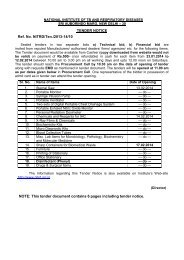October - LRS Institute of Tuberculosis & Respiratory Diseases
October - LRS Institute of Tuberculosis & Respiratory Diseases
October - LRS Institute of Tuberculosis & Respiratory Diseases
You also want an ePaper? Increase the reach of your titles
YUMPU automatically turns print PDFs into web optimized ePapers that Google loves.
A CORRELATIVE STUDY ON ISOTOPE RENOGRAPHY, INTRAVENOUS<br />
PYELOGRAPHY AND URINE CULTURES POSITIVE FOR MYCOBACTERIUM<br />
TUBERCULOSIS IN TUBERCULOUS PATIENTS<br />
P.K. MUKHERJI, 1 K.D. VERMA;, 2 S.K. AGARWAL AND R. PRASAD 3<br />
Summary : Urine specimens from patients <strong>of</strong> pulmonary tuberculosis (100 patients) and osteoarticular<br />
tuberculosis (50 patients) were submitted routinly for mycobacterial cultures. 16 patients<br />
(10.7%) were found to have positive urine culture for M. tuberculosis. Isotope renography depicted<br />
abnormalities <strong>of</strong> various types in 13 (81.2%) patients, while I.V.P. indicated abnormalities only in 7<br />
(43.7 %) patients. It was evident that isotope renogram is a much better marker to defect renal involvement.<br />
In 7 patients (4.6%) a positive urine culture for M. tuberculosis was not anticipated, and in 3<br />
patients isotope renograms and I.V.P. were also normal. Thus normal symptoms or normal tests<br />
do not necessarily exclude the possibility <strong>of</strong> genito-urinary tuberculosis.<br />
Introduction<br />
<strong>Tuberculosis</strong> bacilluria is known to be<br />
associated with tuberculosis <strong>of</strong> various sites <strong>of</strong><br />
the body and many workers believe that renal<br />
tuberculosis can exist without clinical manifestations<br />
(Hobbs, 1923; Medlar, 1926; Medlar<br />
Spain and Holliday, 1949; Wechsler, West fall<br />
and Lattimer, 1960; Bentz et al 1975). In the<br />
present work we have tried to determine the<br />
frequency <strong>of</strong> this occurrence and to correlate the<br />
positive urine cultures for Mycobacterium tuberculosis<br />
with isotope renography and intravenous<br />
pyelography,<br />
Material and Methods<br />
100 bacteriologically confirmed patients <strong>of</strong><br />
pulmonary tuberculosis and 50 patients <strong>of</strong> osteoarticular<br />
tuberculosis were included in the study.<br />
Basis <strong>of</strong> diagnosis in the latter group was<br />
clinical and radiological evidence with a positive<br />
tuberculosis reaction. Following specific<br />
investigations were conducted:—<br />
(a) Urinalysis and routine urine culture for<br />
Mycobacterium tuberculosis was done<br />
in all patients.<br />
(b) Isotope renography was performed in<br />
those patients where urine culture was<br />
positive for mycobacterium tuberculosis.<br />
(c) Intravenous pyelography was performed<br />
in those patients, where urine culture<br />
was positive for mycobacterium tuber<br />
culosis.<br />
(b) Urine Culture for Mycobacterium<br />
<strong>Tuberculosis</strong><br />
All drugs were discontinued for at least 5<br />
days prior to collection <strong>of</strong> urine. Early morning,<br />
first voided urine specimens <strong>of</strong> all the patients<br />
were submitted for mycobacterial culture<br />
(Kenny, Loechel and Lovelock I960; Agarwal,<br />
Srivastava and Prasad 1981). Cultures were<br />
done under strict sterile condition on Lowenstein<br />
—Jensen media by Petr<strong>of</strong>f’s concentration<br />
technique (Cruickshank 1975). The media were<br />
incubated in an incubator at a temperature <strong>of</strong><br />
37°C for a period <strong>of</strong> 6 to 8 weeks. Mycobacterium<br />
tuberculosis was identified by typical<br />
colony morphology and bio-chemical test<br />
(Cruickshank 1975).<br />
(b) Isotope Renography<br />
Isotope renography was done according to<br />
the standard method (Witc<strong>of</strong>ski et al 1961).<br />
Site <strong>of</strong> kidney was localised earlier by a plain<br />
X-ray abdomen or by an intravenous pyelogram.<br />
After proper preparation <strong>of</strong> the patients,<br />
I- 131 Hippuran (Orthoiodo hippuric Acid). 25<br />
uci/Kg. body weight was injected rapidly by<br />
intravenous route. Isotope renogram charts<br />
were obtained and analysed for any abnormal<br />
findings.<br />
Qualitative analysis was done according to<br />
the criteria <strong>of</strong> Kennedy et al (1965). Renograms<br />
were classified into unilateral or bilateral<br />
abnormalities and were grouped into three<br />
types :—<br />
(1) Flattening <strong>of</strong> all the phases suggesting<br />
parenchymal damage (Type A).<br />
(2) Flattening <strong>of</strong> secretory phase, lowered<br />
somewhat delayed peak, indicating<br />
impaired vascular and tubular functions<br />
(Type B).<br />
1. Department <strong>of</strong> <strong>Tuberculosis</strong><br />
2. Department <strong>of</strong> Surgery<br />
3. Department <strong>of</strong> Pathology and Bacteriology, King George’s Medical College, Lucknow<br />
Ind. J. Tub., Vol. XXIX, No. 4

















